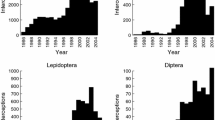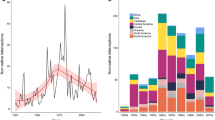Abstract
Introductions of invasive nonindigenous species, and the ensuing negative ecological and economic consequences, have increased with expanding global trade. Quantifying the influx of nonindigenous plant pest species through foreign trade is required for national and international risk assessments, monitoring and conservation efforts, and evaluation of ecological factors that affect invasion success. Here we use statistically robust data collected at US ports of entry and border crossings to estimate arrival rates of nonindigenous insect species via four cargo pathways and to evaluate the effectiveness of current efforts to monitor arrival of nonindigenous insect species. Interception rates were highest in refrigerated maritime cargo where a new insect species was intercepted on average every 54 inspections. Projected estimates of insect species richness stabilized only for non-refrigerated maritime cargo and US–Mexico border cargo, where inspectors likely detected 19–2% and 30–50% of the species being transported through these respective pathways. Conservative estimates of establishment suggest that 42 insect species may have become established through these four pathways between 1997 and 2001.
Similar content being viewed by others
References
RS Anderson JS Ashe (2000) ArticleTitleLeaf litter inhabiting beetles as surrogates for establishing priorities for conservation of selected tropical montane cloud forests in Honduras, Central America (Coleoptera; Staphylinidae, Curculionidae) Biodiversity and Conservation 9 617–653
JE Byers S Reichard JM Randall IM Parker CS Smith WM Lonsdale IAE Atkinson TR Seastedt M Williamson E Chornesky D Hayes (2002) ArticleTitleDirecting research to reduce the impacts of nonindigenous species Conservation Biology 16 630–640
A-MA Calcott HL Collins (1996) ArticleTitleInvasion and range expansion of imported fire ants (Hymenoptera: Formicidae) in North America from 1918–1995 Florida Entomologist 79 240–251
JT Carlton JB Geller (1993) ArticleTitleEcological roulette; the global transport of nonindigenous marine organisms Science 261 78–82
A Chao (1987) ArticleTitleEstimating the population size for capture–recapture data with unequal catchability Biometrics 43 783–791 Occurrence Handle3427163 Occurrence Handle1:STN:280:DyaL1c7gsl2qsw%3D%3D
A Chao SM Lee (1992) ArticleTitleEstimating the number of classes via sample coverage Journal of the American Statistical Association 87 210–217
Colwell RK (1997) Estimates: Statistical Estimation of Species Richness and Shared Species from Samples. Version 5. User’s Guide and Application published at: http://viceroy. eeb.uconn.edu/estimates
RK Colwell JA Coddington (1994) ArticleTitleEstimating terrestrial biodiversity through extrapolation Philosophical Transactions of the Royal Society of London B Biological Sciences 345 101–118 Occurrence Handle1:STN:280:DyaK2M%2Fmt1GltA%3D%3D
MJ Crawley (1989) ArticleTitleThe population biology of invaders Philosophical Transactions of the Royal Society of London B Biological Sciences 314 321–359
di Castri F (1989) History of biological invasions with special emphasis on the old world. In: Drake JA (ed) Biological Invasions: a Global Perspective, pp 1–30. Wiley and Sons
A Foggo SD Rundle DT Bilton (2003) ArticleTitleThe net result: evaluating species richness extrapolation techniques for littoral pond invertebrates Freshwater Biology 48 1756–1764
BS Galil N Hulsmann (1997) ArticleTitleProtist transport via ballast water–Biological classification of ballast tanks by food web interactions European Journal of Protistology 33 244–253
S Gollasch (2002) ArticleTitleThe importance of ship hull fouling as a vector of species introductions into the North Sea Biofouling 18 105–121
NJ Gotelli RK Colwell (2001) ArticleTitleQuantifying biodiversity: procedures and pitfalls in the measurement and comparison of species richness Ecology Letters 4 379–391
RA Haack (2001) ArticleTitleIntercepted Scolytidae (Coleoptera) at US ports of entry: 1985–2000 Integrated Pest Management Reviews 6 253–282
GM Hallegraeff CJ Bolch (1992) ArticleTitleTransport of diatom and dinoflagellate resting spores in ships ballast water: implications for plankton biogeography and aquaculture Journal of Plankton Research 14 1067–1084
N Hulsmann BS Galil (2001) ArticleTitleThe effects of freshwater flushing on marine heterotrophic protists–implications for ballast water management Marine Pollution Bulletin 42 1082–1086 Occurrence Handle11763219 Occurrence Handle1:CAS:528:DC%2BD3MXos1Whtrs%3D
SM Lee A Chao (1994) ArticleTitleEstimating population size via sample coverage for closed capture–recapture models Biometrics 50 88–97 Occurrence Handle1:STN:280:DC%2BD1MznvFCqsg%3D%3D Occurrence Handle19480084
E Leppakoski S Gollasch P Gruszka H Ojaveer S Olenin V Panov (2002) ArticleTitleThe Baltic–a sea of invaders Canadian Journal of Fisheries and Aquatic Sciences 59 1175–1188
A Locke DM Reid HC Vanleeuwen WG Sprules JT Carlton (1993) ArticleTitleBallast water exchange as a means of controlling dispersal of fresh-water organisms by ships Canadian Journal of Fisheries and Aquatic Sciences 50 2086–2093 Occurrence Handle10.1139/f93-232
RN Mack D Simberloff WM Lonsdale H Evans M Clout FA Bazzaz (2000) ArticleTitleBiotic invasions: Causes, epidemiology, global consequences and control Ecological Applications 10 689–710
National Research Council (2001) Committee on the Scientific Basis for Predicting the Invasive Potential of Nonindigenous Plants and Plant Persts into the United States. National Academy Press, pp 1–194
P Niemelä WJ Mattson (1996) ArticleTitleInvasion of North American forests by European phytophagous insects Bioscience 46 741–753
DJ Nowak JE Pasek RA Sequeira DE Crane VC Mastro (2001) ArticleTitlePotential effect of Anoplophora glabripennis (Coleoptera: Cerambycidae) on urban trees in the United States Journal of Economie Entomology 94 116–122 Occurrence Handle1:STN:280:DC%2BD3M7psVCmsQ%3D%3D Occurrence Handle10.1603/0022-0493-94.1.116
RW Pierce JT Carlton DA Carlton JB Geller (1997) ArticleTitleBallast water as a vector for tintinnid transport Marine Ecology-Progress Series 149 295–297
D Pimentel L Lach R Zuniga D Morrison (2000) ArticleTitleEnvironmental and economic costs of nonindigenous species in the United States Bioscience 50 53–65
HI Rainwater (1963) ArticleTitleAgricultural insect pest hitchikers on aircraft Proceedings of the Hawaiian Entomological Society 28 303–309
RI Sailer (1978) ArticleTitleOur immigrant insect fauna Bulletin of the Entomological Society of America 24 3–11
K Shea P Chesson (2002) ArticleTitleCommunity ecology theory as a framework for biological invasions Trends in Ecology and Evolution 17 170–176
MA Stanaway MP Zalucki PS Gillespie CM Rodriguez GV Maynard (2001) ArticleTitlePest risk assessment of insects in sea cargo containers Australian Journal of Entomology 40 180–192
US Congress (1993) Harmful nonindigenous species in the United States. OTA-F-565. Office of Technology, pp 1–397
RC Venette RD Moon WD Hutchison (2002) ArticleTitleStrategies and statistics of sampling for rare individuals Annual Review of Entomology 47 143–174 Occurrence Handle11729072 Occurrence Handle1:CAS:528:DC%2BD38XnvVWnuw%3D%3D
PM Vitousek CM Dantonio LL Loope M Rejmanek R Westbrooks (1997) ArticleTitleIntroduced species: a significant component of human-caused global change New Zealand Journal of Ecology 21 1–16
PM Vitousek CM Dantonio LL Loope R Westbrooks (1996) ArticleTitleBiological invasions as global environmental change American Scientist 84 468–478
Williamson MH (1996) Biological Invasions. Chapman & Hall, pp 1–224.
Author information
Authors and Affiliations
Corresponding author
Rights and permissions
About this article
Cite this article
Work, T.T., McCullough, D.G., Cavey, J.F. et al. Arrival rate of nonindigenous insect species into the United States through foreign trade. Biol Invasions 7, 323–332 (2005). https://doi.org/10.1007/s10530-004-1663-x
Received:
Accepted:
Issue Date:
DOI: https://doi.org/10.1007/s10530-004-1663-x




